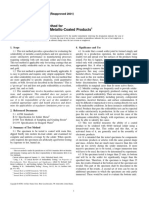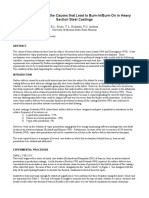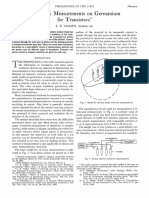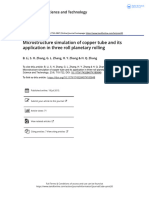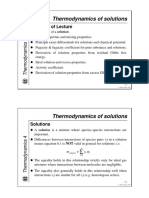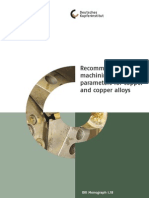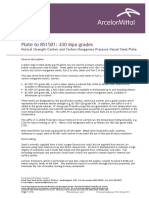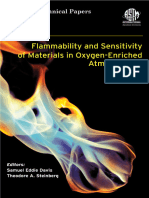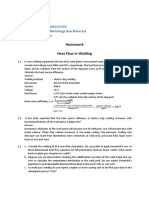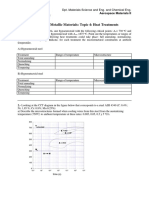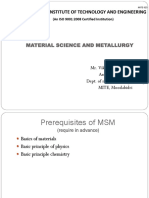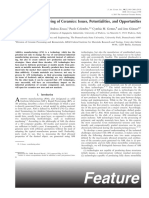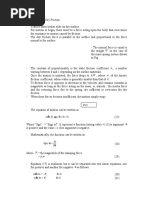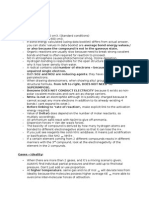Intermetallics PDF
Intermetallics PDF
Uploaded by
gurudev001Copyright:
Available Formats
Intermetallics PDF
Intermetallics PDF
Uploaded by
gurudev001Original Title
Copyright
Available Formats
Share this document
Did you find this document useful?
Is this content inappropriate?
Copyright:
Available Formats
Intermetallics PDF
Intermetallics PDF
Uploaded by
gurudev001Copyright:
Available Formats
Advanced Materials
Intermetallics for Manufacturing
February 2005
INTERMETALLIC MATERIALS are a
unique class of materials having characteristics of
both metals and ceramics. They differ from
conventional metal alloys in that they generally
possess long-range-ordered crystal structures. The
predominant bonding patterns found in ceramics are
highly directional covalent and ionic bonds,
whereas the unique deformation properties of
metals are due to non-directional metallic bonding.
Intermetallics contain both metallic and covalent
bonds, depending on the constituent metals. Mixed
bonding provides mechanical properties that are
Ordered Structure
Non-Ordered Structure
between metals (which are generally softer and
more ductile) and ceramics (which are generally
harder and more brittle).
High-temperature strength and superior oxidation
resistance make intermetallic materials exceptional
candidates for use in high temperature component
design providing not only longer equipment servicelife but the potential to operate at above normal
temperatures. Promising applications include heattreating fixtures, transfer rolls for hot metal
processing, forging dies, radiant burner tubes, or
pyrolyzer parts. The high-temperature strength and
superior oxidation resistance of these materials
would allow increases in operating temperature for
many industrial processes, with resulting dramatic
improvements in thermal energy efficiency and
reduced residence time of chemical reactants at
critical temperatures.
INTERMETALLIC DEVELOPMENT
The Department of Energy (DOE) began funding
the investigation of intermetallic materials at the
Oak Ridge National Laboratory (ORNL) in 1981.1
It has been one of the longest continuously funded
materials development programs ever undertaken.
Initial work focused on basic investigations of the
effects of microstructure, identification of alloying
elements, and the development of thermochemical
and thermomechanical property databases.
The DOE Office of Energy Efficiency and
Renewable Energys Industrial Technologies
Program (ITP) recognized that the unique properties
of intermetallic compounds could enable the
development of new, energy-efficient technologies
and process systems. ITP began funding R&D on
nickel aluminide intermetallics in the early 1990s.
As a result of cost-shared R&D with industrial
partners, intermetallic alloys have been deployed
commercially in a variety of manufacturing
applications.
NICKEL ALUMINIDE INTERMETALLICS
ORNL identified the nickel aluminide intermetallic
(Ni3Al) as having unique high-temperature strength
and oxidation resistance. Its highly ordered crystal
structure provides increased creep and yield
strengths with peak yield strength approximately 30
to 40% higher at 1475 to 1650F (800 to 900C)
than at room temperature. Since nickel aluminide
alloys contain up to 12 wt % excess aluminum, they
form a protective aluminum oxide (Al2O3) coating
which slows oxidation. This results in exceptional
resistance to carburization and coking at high
temperatures a characteristic making it ideal for
use in heat treating furnaces, steelmaking, and other
manufacturing processes.
BARRIERS TO USE
Despite the useful properties inherent to the Ni3Al
structure, the brittle texture of the material long
limited its usefulness in industrial settings.
Industrial materials need to be able to absorb and
respond to sudden pressure changes and mechanical
impacts without catastrophic failures typical of
ceramic or brittle materials. In addition, an
intermetallic's unique structural benefits can be lost
when using traditional metal fabrication techniques,
particularly forming and welding. The commercial
application of Ni3Al to industrial processes required
the development of Ni3Al alloys with reduced
brittleness and an increased capability for shape
casting, forming and welding into useful structures.
PATHWAY TO SUCCESSFUL
COMMERCIALIZATION
By adding boron and controlling the nickel-to
aluminum ratio, ORNL scientists were able to
develop Ni3Al alloys exhibiting ductility at room
temperature. Further chemistry modifications
improved intermediate-temperature ductility and
high-temperature oxidation resulting in
compositions that were potentially useful for
industrial applications.
Controlled composition ductile alloys were difficult
to make, and commercialization was hindered until
the early 1990s when ORNL developed a process
suitable for producing industrial quantities of the
intermetallic materials. The Exo-Melt process
uses a specialized furnace-loading arrangement to
control the exothermic heat from the reaction of
aluminum with nickel; energy is provided more
rapidly to the materials while the ideal composition
concentrations are maintained. This process
reduces melting and holding times and minimizes
silicon pick-up and other reactions with furnace
refractories. Exomelt also addressed important cost
and safety concerns in making Ni3Al. The process
received a 1995 R&D 100 Award and has been
widely adopted by industry.2
Ni3Al and other intermetallics, especially iron and
titanium aluminides, showed promise in a wide
variety of industrial applications. The metallurgical
and mechanical properties of intermetallic alloys
were to be improved by enhancing ductility,
toughness, strength, creep and oxidation resistance.
Intermetallic casting studies determined
solidification behavior, mold interactions, fluidity,
hot shortness, and other casting properties.
Welding studies evaluated cracking susceptibility,
weld properties, process development, and thermal
and environmental aging behavior. Metalworking
issues were addressed through hot ductility testing.
The results of these studies were used to predict and
adjust alloy compositions for specific industrial
applications and fabrication techniques including
the casting, welding and coating/cladding of
intermetallics with properties suitable for
conventional code-approved structures.
In 1992, a specific industrial application was
identified to exploit the excellent thermal and
corrosion resistance properties of Ni3Al cast
materials and reduce energy consumption.3 Nickel
aluminide heat-treating trays (upper fixtures, lower
fixtures, and support posts) were cast. Each tray
assembly could carry 340 kg (750 lb) through a
furnace. Over 65
fixtures were
successfully
fabricated and
installed in 1995 in a
continuous
carburizing furnace at
GM Delphi Saginaw
Steering Systems.
The nickel aluminide
furnace assemblies provided greater carburization
and oxidation resistance, as well as higher elevated
temperature strength and creep strength than steel
alloys. The trays lasted more than three times as
long, reducing both scheduled and unscheduled
down-time considerably. In addition, the lower
mass of the assemblies reduced energy requirements
for heat-treating by 11% and continue to save over
60 million Btu annually at the Saginaw plant. If
utilized across the entire heat treating industry,
roughly 30 trillion Btu could be saved annually in
the United States.
In 2000, a Ni3Al application was initiated that
required both the casting and welding of
intermetallics to make large industrial furnace
continuous caster rollers.4 Traditional roller surfaces
warp, crack and blister. Ni3Al properties minimize
off-spec product that results from roller surface
defects and minimizes furnace maintenance.
Techniques to centrifugally cast large rolls, 17-inch
diameter by 160-inch long, and to weld trunnions
on both ends of the roll were developed.
Benefits derived from the use of intermetallics in
this application include increased service life of
rolls, elimination of the water cooling requirement,
decreased materials rejection rate, and reduced
energy use. Furthermore, efficiency is improved as
a result of not needing to: (1) shut down
austenitizing furnaces for frequent grinding of
current rolls to remove blister, (2) shut down
continuous casters to grind roll surfaces because of
thermal fatigue cracking, (3) replace rolls as
frequently in austenitizing furnaces and continuous
casters and thus casting significantly fewer rolls,
and (4) remelt and process out-of-specification steel
plates due to marring by blisters on current rolls in
the austenitizing furnaces or continuous cast
systems. It is estimated that, if the technology was
broadly adopted, the resulting energy savings will
be over 32 trillion Btu per year.
A total of 101 rolls were fabricated and installed at
the Burns Harbor Plate Mill in 2002. These have
provided over two years of uninterrupted superior
service.5 Continuous operation at this mill has
resulted in an additional 210 operational days,
product yields of consistently high quality and a
35% increase in energy efficiency. A total of
215,000 tons of steel plate (3 times the amount of
steel used in the Empire State Building) have been
heat treated. Duraloy (an ORNL licensed
manufacturer of Ni3Al) will soon manufacture 110
new rolls for installation at another U.S. mill.
Project partners have advanced the development of
other Ni3Al applications that include both casting
and welding techniques. Annealing furnaces
frequently use radiant burner tubes that fail due to
creep deformation and oxidation mechanisms.
Ni3Al tubes eliminate these failures. Forging dies
built of cast Ni3Al alloy can remain in service ten
times as long as those fabricated from commercially
used die material. Nickel aluminide forging dies
have been used to successfully forge 100,000 pieces
of a part known as a "brake spider."
New industrial applications of intermetallics are
continuing to emerge. For example, cast or wrought
high-alloy stainless steels used for ethylene furnace
tubes are subject to coke buildup and carburization.
Coke buildup results in lower furnace efficiency
and productivity. Removal of coke from the furnace
tubes is a frequent and energy-intensive operation.
The hydrocarbon feed is stopped, and natural gas
and air are fed into the furnace to combust the coke
deposits. This operation results in the loss of the
fuel value of both the natural gas and the coke.
Elimination of the need for decoking could result in
annual energy savings of over 200 trillion Btu while
simultaneously improving the furnace productivity.
The unique oxide surface chemistry of Ni3Al
hinders the rate of carburization and coke buildup.
Use of Ni3Al for ethylene furnace tubes and
development of novel tube manufacturing and
welding techniques are being investigated.6
FUTURE DEVELOPMENTS AND THE
SUCCESS OF INTERMETALLICS WORK
Other intermetallic alloys developed at ORNL are
showing promise in a variety of industrial settings.
FeAl intermetallics have resistance to carburization
and sulfidation that far exceeds that of most
commercial metal alloys. Ni3Si alloys have good
mechanical properties coupled with excellent
resistance to oxidizing conditions, such as in
sulfuric acid and seawater, and to ammonia at
temperatures up to 900C. Ni3Al and TiAl are also
being characterized and evaluated for potential uses
and commercialization.
ADDITIONAL KEY PUBLICATIONS
a.
V. K. Sikka, Processing of Aluminides, pp. 561-604 in
Physical Metallurgy and Processing of Intermetallic
Compounds, ed. N. S. Stoloff and V. K. Sikka (Chapman
and Hall, New York, NY, 1996).
The intermetallic alloy development program at
ORNL has contributed significantly to the
understanding of intermetallic materials and
processing technologies. The program has been
characterized by outstanding research and effective
coordination between basic and applied research
organizations. Finally, collaborative interactions
between DOE, ORNL and industrial participants
(metal producers and end-users) have contributed to
plant floor energy efficiency improvements through
the implementation of innovative alloy
compositions and processing methods.
b.
V. K. Sikka, M. L. Santella, and R. W. Swindeman,
Ni3Al-Based Alloys in Steel and Heat Treating Furnace
Industry, Materials Research Society, 2000.
c.
V. K. Sikka, S. C. Deevi, S. Viswanathan, R. W.
Swindeman, and M. L. Santella, Advances in Processing
of Ni3Al-Based Intermetallics and Applications, pp.
1329-1337 in Intermetallics 8 (2000): Materials Park,
OH: ASM International.
d.
V. K. Sikka, M. L. Santella, P. Angelini, J. Mengel, R.
Petrusha, A. P. Martocci, and R. I. Pankiw, Large-scale
manufacturing of nickel aluminide transfer rolls for steel
austenitizing furnaces, Intermetallics, Volume 12, pp.
837-844, 2004.
REFERENCES
PATENTS
1. "Industrial Materials of the Future (IMF) Program
Intermetallic Alloy Development"
The Ni3Al research work performed at ORNL is
protected under 27 patents in the United States.
http:/www.oit.doe.gov/imf/pdfs/intermetallicalloystudy8_9.pdf
2. V. K. Sikka, S. C. Deevi, and J. D. Vought, "Exo-Melt: A
Commercially Viable Process," Advanced Materials and
Processes, 147(6), pp. 29-31 (1995).
3. V. K. Sikka, "Newly Developed Ni3Al Heat Treating
Furnace Assemblies are Being Commercialized at
Delphi," April 2001.
http://www.oit.doe.gov/imf/pdfs/ni3alheatfurnace.pdf
4. V. K. Sikka, M. L. Santella, P. Angelini, J. Mengel, R.
Petrusha, A. P. Martocci, L. Fabina, and R. Chango,
Large-Scale Evaluation of Nickel Aluminide Rolls in a
Heat-Treat Furnace at Bethlehem Steel (now ISG) Burns
Harbor Plate Mill, Sept. 2004.
http:/www.oit.doe.gov/imf/pdfs/10_nickel_aluminide_final_report.pdf
5. V. K. Sikka, M. L. Santella, P. Angelini, J. Mengel, R.
Petrusha, A. P. Martocci, and R. I. Pankiw, Large-Scale
Manufacturing of Nickel Aluminide Transfer Rolls for
Steel Austenitizing Furnaces, Intermetallics, Volume 12,
pp. 837-844 (2004).
6. "Oxide-dispersion Strengthened Tubes Will Enable
Higher Operating Temperatures, Leading to More
Efficient Ethylene Production."
http://www.oit.doe.gov/imf/pdfs/1783ethylenetubessum.pdf
LICENSES
Six licensed companies are producing nickel
aluminide alloys for the manufacture of industrial
components in the United States.
CONTACT INFORMATION:
Dr. Vinod K. Sikka
Metals and Ceramics Division
Oak Ridge National Laboratory
P.O. Box 2008
Oak Ridge, TN 37831-6083
Telephone: (865) 574-5112 Fax: (865) 574-4357
E-mail: sikkavk@ornl.gov
Visit the Industrial Technologies Program Web site
at: http://www.eere.energy.gov/industry/
The EERE Information Center also answers
questions on EERE's products, services, and 11
technology programs. You may contact the EERE
Information Center by calling 1-877-EERE-INF (1
877-337-3463) or online at
http://www.eere.energy.gov/informationcenter/
You might also like
- ASTM B-678 Solderability TestDocument3 pagesASTM B-678 Solderability TestTeenTeen GaMingNo ratings yet
- Sodium InstrumentationDocument9 pagesSodium InstrumentationsumanthrgowdaNo ratings yet
- PC 23 SpecDocument19 pagesPC 23 Speccht0% (1)
- An Investigation of The Causes That Lead To Burn-InBurn-On in Heavy PDFDocument13 pagesAn Investigation of The Causes That Lead To Burn-InBurn-On in Heavy PDFTraian TiberiuNo ratings yet
- Valdez - Proc. Inst Radio Engrs Vol 42 Pag420 1954Document8 pagesValdez - Proc. Inst Radio Engrs Vol 42 Pag420 1954Jacinto CanekNo ratings yet
- Thermal Processing of MetalsDocument63 pagesThermal Processing of MetalsNagaVenkateshGNo ratings yet
- Microstructure Simulation of Copper Tube and Its Application in Three Roll Planetary RollingDocument9 pagesMicrostructure Simulation of Copper Tube and Its Application in Three Roll Planetary RollingandrreaskinzNo ratings yet
- Module 21Document82 pagesModule 21Nirav ParmarNo ratings yet
- Welding "Grade 91" Alloy Steel: Less Than 1.05%Document5 pagesWelding "Grade 91" Alloy Steel: Less Than 1.05%Anonymous nw5AXJqjdNo ratings yet
- Thermodynamics of SolutionsDocument9 pagesThermodynamics of SolutionsAshfaque AhmedNo ratings yet
- Astm A276-06Document7 pagesAstm A276-06NadhiraNo ratings yet
- Mathematical Modelling of GTAW and GMAWDocument240 pagesMathematical Modelling of GTAW and GMAWpatriciatavares2009100% (2)
- Datasheet DMV 304 HCu 20081118Document4 pagesDatasheet DMV 304 HCu 20081118Anuj ShahiNo ratings yet
- The Effect of SAW Parameters On W e L D Metal ChemistryDocument6 pagesThe Effect of SAW Parameters On W e L D Metal ChemistryBhalakrishnan G SNo ratings yet
- Heat Treatment of 1045 Steel PDFDocument17 pagesHeat Treatment of 1045 Steel PDFH_DEBIANENo ratings yet
- Brass MachiningDocument68 pagesBrass MachiningVaibhav ShuklaNo ratings yet
- Compatibility of Metals. Alloys With Static Pb-LiDocument101 pagesCompatibility of Metals. Alloys With Static Pb-LikambletanajiNo ratings yet
- Berkovich EngDocument34 pagesBerkovich Engויליאם סן מרמיגיוסNo ratings yet
- Statistical Methods and Thermodynamics - BatistaDocument97 pagesStatistical Methods and Thermodynamics - BatistapepeperezNo ratings yet
- Web Datasheet A6.2Document4 pagesWeb Datasheet A6.2wolf_nsNo ratings yet
- EPRI - TraduzidoDocument80 pagesEPRI - TraduzidoFrederico GarciaNo ratings yet
- STP 1543-2015Document1,178 pagesSTP 1543-2015HieuHTNo ratings yet
- LT26G PDFDocument4 pagesLT26G PDFraul gonzalezNo ratings yet
- Engineering Materials Geoffrey W Meetham M B E Prof DR Ir Marcel H Van de Voorde Auth Materials For High Temperature Engineering Applicati PDFDocument173 pagesEngineering Materials Geoffrey W Meetham M B E Prof DR Ir Marcel H Van de Voorde Auth Materials For High Temperature Engineering Applicati PDFIlham HakikiNo ratings yet
- Asme B16.18 (2001)Document66 pagesAsme B16.18 (2001)amerNo ratings yet
- As 1038.12.2-1999 Coal and Coke - Analysis and Testing Higher Rank Coal - Caking and Coking Properties - DeteDocument6 pagesAs 1038.12.2-1999 Coal and Coke - Analysis and Testing Higher Rank Coal - Caking and Coking Properties - DeteSAI Global - APACNo ratings yet
- Technical Data Sheet: Industrial GrapheneDocument3 pagesTechnical Data Sheet: Industrial GrapheneAnonymous CzYqnr2RmNo ratings yet
- Huang 2014Document9 pagesHuang 2014Oscar Santos EstofaneroNo ratings yet
- STP 1561-2012Document322 pagesSTP 1561-2012HieuHTNo ratings yet
- Cubic Boron NitrideDocument15 pagesCubic Boron Nitridekaran sahniNo ratings yet
- Nuclear Systems Volume I Thermal Hydraulic Fundamentals 2nd Edition Neil E. Todreas download pdfDocument82 pagesNuclear Systems Volume I Thermal Hydraulic Fundamentals 2nd Edition Neil E. Todreas download pdfoflynnjoosee100% (7)
- Acoustic Resonance in Heat ExchangerDocument7 pagesAcoustic Resonance in Heat Exchangershakil ahmadNo ratings yet
- C 781 - 02 - QZC4MQDocument8 pagesC 781 - 02 - QZC4MQmarkNo ratings yet
- Unit 2 PDFDocument4 pagesUnit 2 PDFabhiazad100% (1)
- Metallurgy Gate Books To PurchaseDocument1 pageMetallurgy Gate Books To PurchaseSrinivasulu PuduNo ratings yet
- 2phase Flow and Boiling Heat TransferDocument218 pages2phase Flow and Boiling Heat TransfercmegmhiNo ratings yet
- CR39W (HPNB)Document2 pagesCR39W (HPNB)Jean-Noël LerouxNo ratings yet
- A213A213M-15b Standard Specification For Seamless Ferritic and Austenitic Alloy-Steel Boiler, Superheater, and Heat-Exchanger TubesDocument14 pagesA213A213M-15b Standard Specification For Seamless Ferritic and Austenitic Alloy-Steel Boiler, Superheater, and Heat-Exchanger TubesChuthaNo ratings yet
- Advances in Catalysis, Volume 57 Chapter 1Document97 pagesAdvances in Catalysis, Volume 57 Chapter 1Abhishek AbhiNo ratings yet
- Case Study On Copper CorrosionDocument15 pagesCase Study On Copper CorrosionClaudia MmsNo ratings yet
- Technology For Electromagnetic Stirring of Aluminum Reverberatory FurnacesDocument6 pagesTechnology For Electromagnetic Stirring of Aluminum Reverberatory FurnacesghndslNo ratings yet
- Materials Selection: DeskbookDocument4 pagesMaterials Selection: DeskbooklotannaNo ratings yet
- Exercises Topic 4 Heat TreatmentsDocument14 pagesExercises Topic 4 Heat TreatmentsClara Barbero SánchezNo ratings yet
- HF WeldingDocument35 pagesHF WeldingLuka BugarinNo ratings yet
- Mangalore Institute of Technology and Engineering: Material Science and MetallurgyDocument203 pagesMangalore Institute of Technology and Engineering: Material Science and MetallurgyNISHAANTH S 1861462No ratings yet
- 34CrMo4 TezDocument52 pages34CrMo4 TezAhmet ŞahinNo ratings yet
- NFCDocument46 pagesNFCLuptongaNo ratings yet
- CVD Silicon Carbide PDFDocument7 pagesCVD Silicon Carbide PDFreaktorenergiNo ratings yet
- Draft Scope Matrix BSL - KCCDocument2 pagesDraft Scope Matrix BSL - KCCkoushik42000No ratings yet
- Astm A105 A105m 21Document5 pagesAstm A105 A105m 21miraclemj35No ratings yet
- Zocca2015 PDFDocument19 pagesZocca2015 PDFBeesam Ramesh KumarNo ratings yet
- B.E.Materials Science R2015Document103 pagesB.E.Materials Science R2015Hawe HydraulicsNo ratings yet
- Material PC - CorrproDocument61 pagesMaterial PC - CorrproHugo SuescunNo ratings yet
- MT305 Nonferrous Extractive MetallurgyDocument2 pagesMT305 Nonferrous Extractive MetallurgyMerrin John VarkeyNo ratings yet
- Application of Refractory Metals and AlloysDocument36 pagesApplication of Refractory Metals and Alloysbugoff700No ratings yet
- Cerium-Based, Intermetallic-Strengthened Aluminum Casting Alloy-High-Volume Co-Product DevelopmentDocument14 pagesCerium-Based, Intermetallic-Strengthened Aluminum Casting Alloy-High-Volume Co-Product DevelopmentLilian Jefferson MalavaziNo ratings yet
- Solutions For Specialty Alloy Piping RequirementsDocument4 pagesSolutions For Specialty Alloy Piping RequirementsNagalingeswaran RNo ratings yet
- Special Metals-Corrosion-resistant Alloys For Oil and Gas Production PDFDocument44 pagesSpecial Metals-Corrosion-resistant Alloys For Oil and Gas Production PDFagnotts09No ratings yet
- John Harvey and Samantha Birch: Important Factors in The Selection of Steel Ladle Lining MaterialsDocument8 pagesJohn Harvey and Samantha Birch: Important Factors in The Selection of Steel Ladle Lining MaterialssadhuNo ratings yet
- Development and Application of Nickel Alloys in Aerospace Engineering PDFDocument9 pagesDevelopment and Application of Nickel Alloys in Aerospace Engineering PDFAditya Budi FauziNo ratings yet
- Engineering - Issues, Challenges and Opportunities For DevelopmentDocument392 pagesEngineering - Issues, Challenges and Opportunities For DevelopmentsitinurulhazwaniNo ratings yet
- 8040 Datasheet PDFDocument2 pages8040 Datasheet PDFrahul.yerrawarNo ratings yet
- Coulomb DampingDocument6 pagesCoulomb Dampinggurudev001No ratings yet
- Engineer and Engineers DoDocument1 pageEngineer and Engineers Dogurudev001No ratings yet
- Measurement of ElasticDocument1 pageMeasurement of Elasticgurudev001No ratings yet
- 2013 Virtual Academy: Creative Computer Programming For Engineering Simulations and Animations Lecture 1Document1 page2013 Virtual Academy: Creative Computer Programming For Engineering Simulations and Animations Lecture 1gurudev001No ratings yet
- 2013 Virtual Academy: Introduction To Metal FormingDocument1 page2013 Virtual Academy: Introduction To Metal Forminggurudev001No ratings yet
- Lakshmi Venkateswara Gardens: NorthDocument1 pageLakshmi Venkateswara Gardens: Northgurudev001No ratings yet
- 2016 - Center 6 SeatingDocument34 pages2016 - Center 6 Seatinggurudev001No ratings yet
- Watch: For Diabetic PatientsDocument8 pagesWatch: For Diabetic Patientsgurudev001No ratings yet
- TM163 1015 Centre of PercusionDocument2 pagesTM163 1015 Centre of Percusiongurudev001No ratings yet
- TM163 1015 Centre of PercusionDocument2 pagesTM163 1015 Centre of Percusiongurudev001No ratings yet
- TM160 1015 Free VibrationsDocument2 pagesTM160 1015 Free Vibrationsgurudev001No ratings yet
- Free Mechanical Engineering SoftwaresDocument23 pagesFree Mechanical Engineering Softwaresgurudev001No ratings yet
- Ntu Mae UgDocument53 pagesNtu Mae Uggurudev001100% (1)
- Max Marks: 20 (For Ece & Eee) Time:20 MinsDocument1 pageMax Marks: 20 (For Ece & Eee) Time:20 Minsgurudev001No ratings yet
- VatsavDocument8 pagesVatsavgurudev001No ratings yet
- ScimagojrDocument766 pagesScimagojrgurudev001No ratings yet
- Department of Mechanical Engineering 4/4 B. Tech - Mechanical Engineering - II Semester - 2014-15 List of Project Students and Faculty SupervisorsDocument7 pagesDepartment of Mechanical Engineering 4/4 B. Tech - Mechanical Engineering - II Semester - 2014-15 List of Project Students and Faculty Supervisorsgurudev001No ratings yet
- Sharpen Your Solidworks Skills: Become A Solidworks Accredited EducatorDocument2 pagesSharpen Your Solidworks Skills: Become A Solidworks Accredited Educatorgurudev001No ratings yet
- 12 Chemistry Q.p.set-3Document6 pages12 Chemistry Q.p.set-3HpNo ratings yet
- Form 2 Chemistry NotesDocument5 pagesForm 2 Chemistry NotesSharon MuchetoNo ratings yet
- By Prin Ces Ir: He Olid TateDocument49 pagesBy Prin Ces Ir: He Olid TateVinayNo ratings yet
- PSC Att Teacher SyllabusDocument19 pagesPSC Att Teacher SyllabusSamim Al RashidNo ratings yet
- Metal NitrosylDocument206 pagesMetal NitrosylSandipan SahaNo ratings yet
- Chemical Bonding: Chapter 6 ReviewDocument8 pagesChemical Bonding: Chapter 6 ReviewCabdicasiis Maxamuud GuuleedNo ratings yet
- The I Nfrared Spectra of Complex Molecules: Advances in Infrared Group FrequenciesDocument308 pagesThe I Nfrared Spectra of Complex Molecules: Advances in Infrared Group FrequenciesLucilaNo ratings yet
- Chemistry For Engineer Module 1 SummaryDocument5 pagesChemistry For Engineer Module 1 SummaryMhonn Czedrick YbañezNo ratings yet
- Plutonium: A Wartime Nightmare But A Metallurgist's DreamDocument10 pagesPlutonium: A Wartime Nightmare But A Metallurgist's DreamMiloš BulajićNo ratings yet
- Chapter 4 Chemical Bonding and Molecular StructureDocument26 pagesChapter 4 Chemical Bonding and Molecular StructureYash PlayNo ratings yet
- Electro NegativityDocument6 pagesElectro NegativityWarisha AkbarNo ratings yet
- Chemistry-1st PU: 2&3 Marks Important QuestionsDocument9 pagesChemistry-1st PU: 2&3 Marks Important QuestionsDaksha SubrhamanyaNo ratings yet
- Nonwoven Bags Project Report DubaiDocument54 pagesNonwoven Bags Project Report Dubaisugaimpax80% (10)
- Hybridization TarakkyDocument36 pagesHybridization TarakkyKhondokar TarakkyNo ratings yet
- Chemistry Notes Form 4 PDF Free PDFDocument28 pagesChemistry Notes Form 4 PDF Free PDFJane DoeNo ratings yet
- Organic Chemistry NotesDocument6 pagesOrganic Chemistry NotesAzib ZararNo ratings yet
- Introductory Chemistry Atoms First 5th Edition Russo Solutions ManualDocument26 pagesIntroductory Chemistry Atoms First 5th Edition Russo Solutions Manualduongvalerie9rkb3100% (34)
- Worksheet 5.1: Kinetic Theory and The General Gas EquationDocument4 pagesWorksheet 5.1: Kinetic Theory and The General Gas EquationfdjjNo ratings yet
- 0620 GceDocument12 pages0620 Gcenitha telkar nitaNo ratings yet
- CMC Chapter 08Document125 pagesCMC Chapter 08MattNo ratings yet
- C Yr09 MQF Lev1to3 2023Document12 pagesC Yr09 MQF Lev1to3 2023AdrianHedleyNo ratings yet
- Sophisticated ChemistryDocument9 pagesSophisticated ChemistryKingsleyNo ratings yet
- S9 Q2 HYBRID MODULE 4B Week 5 Final PDFDocument17 pagesS9 Q2 HYBRID MODULE 4B Week 5 Final PDFSally CustodioNo ratings yet
- Lewis Structures HandoutDocument21 pagesLewis Structures HandoutbaleahNo ratings yet
- 1955.01.06 Mulliken JCP Electronic-Population-AnalysisDocument9 pages1955.01.06 Mulliken JCP Electronic-Population-AnalysisAlejandra AwimbaweNo ratings yet
- Intermolecular Forces: Liquids, Solids, and Phase ChangesDocument57 pagesIntermolecular Forces: Liquids, Solids, and Phase ChangesB13, Jerex MaxilumNo ratings yet
- Dap AnDocument86 pagesDap AnNguyễn Duyên KhươngNo ratings yet
- H2 Chemistry NotesDocument9 pagesH2 Chemistry NotescsngNo ratings yet
- BioChemistry Report Group 2 ProteinDocument42 pagesBioChemistry Report Group 2 ProteinMiguel BelusoNo ratings yet
- 10 1021@acs Chemrev 9b00842Document52 pages10 1021@acs Chemrev 9b00842Hà An Đỗ NgọcNo ratings yet
